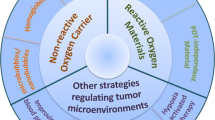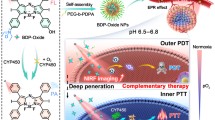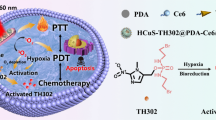Abstract
Metastasis remains the primary cause for mortality of breast cancer. Despite advances in current therapeutic agents, patients with metastatic breast cancer still have poor prognoses. Tumor hypoxia, a key microenvironment factor, is emerging as an attractive target to prevent metastasis and is also involved with resistance to phototherapy. Here, we show an effective nanotherapeutic approach based on manganese dioxide-coated polydopamine nanocarriers to trigger robust anti-tumor and anti-metastasis responses against metastatic breast cancer by supplemental oxygenation and multimodal imaging-guided phototherapies. In cancer cells, the produced oxygen by the developed nanoplatform decreases the expression of hypoxia-inducible factors 1\ga to inhibit tumor metastasis, and enhances the efficacy of photodynamic therapy. This nanotherapeutic approach enables the combined photodynamic/photothermal treatments with great inhibition on cell migration and invasion in vitro. Moreover, the nanotherapeutics effectively suppresses primary tumor progress and inhibits lung metastasis in vivo in a breast cancer mouse model with satisfying biosafety. This study suggests that the tumor hypoxia-targeting nanotherapeutics have great potential for preventing and treating metastatic cancers.

Similar content being viewed by others
References
Siegel, R. L.; Miller, K. D.; Jemal, A. Cancer statistics, 2009. CA Cancer J. Clin.2019, 69, 7–34.
Chaffer, C. L.; Weinberg, R. A. A perspective on cancer cell metastasis. Science2011, 331, 1559–1564.
Bianchini, G.; Balko, J. M.; Mayer, I. A.; Sanders, M. E.; Gianni, L. Triple-negative breast cancer: Challenges and opportunities of a heterogeneous disease. Nat. Rev. Clin. Oncol.2016, 13, 674–690.
Steeg, P. S. Targeting metastasis. Nat. Rev. Cancer2016, 16, 201–218.
Massagué, J.; Obenauf, A. C. Metastatic colonization by circulating tumour cells. Nature2016, 529, 298–306.
Eckhardt, B. L.; Francis, P. A.; Parker, B. S.; Anderson, R. L. Strategies for the discovery and development of therapies for metastatic breast cancer. Nat. Rev. Drug Discov.2012, 11, 479–497.
Gilkes, D. M.; Semenza, G. L.; Wirtz, D. Hypoxia and the extracellular matrix: Drivers of tumour metastasis. Nat. Rev. Cancer2014, 14, 430–439.
Sahu, A.; Choi, W. I.; Tae, G. Recent progress in the design of hypoxia-specific nano drug delivery systems for cancer therapy. Adv. Therap.2018, 1, 1800026.
Hanahan, D.; Weinberg, R. A. Hallmarks of cancer: The next generation. Cell2011, 144, 646–674.
Rankin, E. B.; Giaccia, A. J. Hypoxic control of metastasis. Science2016, 352, 175–180.
Palazon, A.; Goldrath, A. W.; Nizet, V.; Johnson, R. S. HIF transcription factors, inflammation, and immunity. Immunity2014, 41, 518–528.
Lu, X.; Kang, Y. Hypoxia and hypoxia-inducible factors: Master regulators of metastasis. Clin. Cancer Res.2010, 16, 5928–5935.
Siemann, D. W.; Horsman, M. R. Modulation of the tumor vasculature and oxygenation to improve therapy. Pharmacol. Therapeut.2015, 153, 107–204.
Ye, Y. Q.; Hu, Q. S.; Chen, H.; Liang, K.; Yuan, Y.; Xiang, Y.; Ruan, H.; Zhang, Z.; Song, A. R.; Zhang, H. W. et al. Characterization of hypoxia-associated molecular features to aid hypoxia-targeted therapy. Nat. Metab.2019, 1, 431–444.
Qian, C. G.; Yu, J. C.; Chen, Y. L.; Hu, Q. Y.; Xiao, X. Z.; Sun, W. J.; Wang, C.; Feng, P. J.; Shen, Q. D.; Gu, Z. Light-activated hypoxiaresponsive nanocarriers for enhanced anticancer therapy. Adv. Mater.2016, 28, 3313–3320.
Xu, C. N.; Wang, P.; Zhang, J. P.; Tian, H. Y.; Park, K.; Chen, X. S. Pulmonary codelivery of doxorubicin and siRNA by pH-sensitive nanoparticles for therapy of metastatic lung cancer. Small2015, 11, 4321–4333.
Montagner, M.; Enzo, E.; Forcato, M.; Zanconato, F.; Parenti, A.; Rampazzo, E.; Basso, G.; Leo, G.; Rosato, A.; Bicciato, S. et al. SHARP1 suppresses breast cancer metastasis by promoting degradation of hypoxia-inducible factors. Nature2012, 487, 380–384.
Xiang, L. S.; Gilkes, D. M.; Chaturvedi, P.; Luo, W. B.; Hu, H. X.; Takano, N.; Liang, H. J.; Semenza, G. L. Ganetespib blocks HIF-1 activity and inhibits tumor growth, vascularization, stem cell maintenance, invasion, and metastasis in orthotopic mouse models of triple-negative breast cancer. J. Mol. Med.2014, 92, 151–164.
Wong, C. C. L.; Zhang, H. F.; Gilkes, D. M.; Chen, J.; Wei, H.; Chaturvedi, P.; Hubbi, M. E.; Semenza, G. L. Inhibitors of hypoxia-inducible factor 1 block breast cancer metastastic niche formation and lung metastasis. J. Mol. Med.2012, 90, 803–815.
Wang, T. H.; Yu, C. C.; Lin, Y. S.; Chen, T. C.; Yeh, C. T.; Liang, K. H.; Shieh, T. M.; Chen, C. Y.; Hsueh, C. Long noncoding RNA CPS1-IT1 suppresses the metastasis of hepatocellular carcinoma by regulating HIF-1α activity and inhibiting epithelial-mesenchymal transition. Oncotarget2016, 7, 43588–43603.
Zhao, J. H.; Luo, Y.; Jiang, Y. G.; He, D. L.; Wu, C. T. Knockdown of β-catenin through shRNA cause a reversal of EMT and metastatic phenotypes induced by HIF-1α. Cancer Invest.2011, 29, 377–382.
Meng, L. T.; Cheng, Y. L.; Tong, X. N.; Gan, S. J.; Ding, Y. W.; Zhang, Y.; Wang, C.; Xu, L.; Zhu, Y. S.; Wu, J. H. et al. Tumor oxygenation and hypoxia inducible factor-1 functional inhibition via a reactive oxygen species responsive nanoplatform for enhancing radiation therapy and abscopal effects. ACS Nano2018, 12, 8308–8322.
Hatfield, S. M.; Kjaergaard, J.; Lukashev, D.; Schreiber, T. H.; Belikoff, B.; Abbott, R.; Sethumadhavan, S.; Philbrook, P.; Ko, K.; Cannici, R. et al. Immunological mechanisms of the antitumor effects of supplemental oxygenation. Sci. Transl. Med.2015, 7, 30–42.
Ramanathan, R. K.; Abbruzzese, J.; Dragovich, T.; Kirkpatrick, L.; Guillen, J. M.; Baker, A. F.; Pestano, L. A.; Green, S.; Von Hoff, D. D. A randomized phase II study of PX-12, an inhibitor of thioredoxin in patients with advanced cancer of the pancreas following progression after a gemcitabine-containing combination. Cancer Chemother. Pharmacol.2011, 67, 503–509.
Williamson, S. K.; Crowley, J. J.; Lara, P. N., Jr.; McCoy, J.; Lau, D. H. M.; Tucker, R. W.; Mills, G. M.; Gandara, D. R. Phase III trial of paclitaxel plus carboplatin with or without tirapazamine in advanced non-small-cell lung cancer: Southwest oncology group trial S0003. J. Clin. Oncol.2005, 9097–9104.
Davidson, A.; Veillard, A. S.; Tognela, A.; Chan, M. M. K.; Hughes, B. G. M.; Boyer, M.; Briscoe, K.; Begbie, S.; Abdi, E.; Crombie, C. et al. A phase III randomized trial of adding topical nitroglycerin to first-line chemotherapy for advanced nonsmall-cell lung cancer: The Australasian lung cancer trials group NITRO trial. Ann. Oncol.2015, 26, 2280–2286.
Salem, A.; Asselin, M. C.; Reymen, B.; Jackson, A.; Lambin, P.; West, C. M. L.; O’Connor, J. P. B.; Faivre-Finn, C. Targeting hypoxia to improve non-small cell lung cancer outcome. J. Natl. Cancer Inst.2018, 110, 14–30.
Heyboer, M., III; Sharma, D.; Santiago, W.; McCulloch, N. Hyperbaric oxygen therapy: Side effects defined and quantified. Adv. Wound Care2017, 6, 210–224.
Cheng, L.; Wang, C.; Feng, L. Z.; Yang, K.; Liu, Z. Functional nanomaterials for phototherapies of cancer. Chem. Rev.2014, 114, 10869–10939.
Pan, M.; Jiang, Q. Y.; Sun, J. L.; Xu, Z.; Zhou, Y. Z.; Zhang, L.; Liu, X. Q. Programming DNA nanoassembly for enhanced photodynamic therapy. Angew. Chem., Int. Ed.2020, 59, 1897–1905.
Juneja, R.; Lyles, Z.; Vadarevu, H.; Afonin, K. A.; Vivero-Escoto, J. L. Multimodal polysilsesquioxane nanoparticles for combinatorial therapy and gene delivery in triple-negative breast cancer. ACS Appl. Mater. Interfaces2019, 11, 12308–12320.
Sheng, J. P.; Zhang, L.; Deng, L.; Han, Y. J.; Wang, L. Q.; He, H. C.; Liu, Y. N. Fabrication of dopamine enveloped WO3-x quantum dots as single-NIR laser activated photonic nanodrug for synergistic photothermal/photodynamic therapy against cancer. Chem. Eng. J.2020, 383, 123071–123079
Zou,L. L.; Wang, H.; He, B.; Zeng, L. J.; Tan, T.; Cao, H. Q.; He, X. Y.; Zhang, Z. W.; Guo, S. R.; Li, Y. P. Current approaches of photothermal therapy in treating cancer metastasis with nanotherapeutics. Theranostics2016, 6, 762–772.
Zhang, D.; Feng, F.; Li, Q. L.; Wang, X. Y.; Yao, L. Nanopurpurinbased photodynamic therapy destructs extracellular matrix against intractable tumor metastasis. Biomaterials2018, 173, 22–33.
Guo, C. S.; Yu, H. J.; Feng, B.; Gao, W. D.; Yan, M.; Zhang, Z. W.; Li, Y. P.; Liu, S. Q. Highly efficient ablation of metastatic breast cancer using ammonium-tungsten-bronze nanocube as a novel 1064 nmlaser-driven photothermal agent. Biomaterials2015, 52, 407–416.
Feng, B.; Zhou, F. Y.; Xu, Z. A.; Wang, T. T.; Wang, D. G.; Liu, J. P.; Fu, Y. L.; Yin, Q.; Zhang, Z. W.; Yu, H. J. et al. Versatile prodrug nanoparticles for acid-triggered precise imaging and organelle-specific combination cancer therapy. Adv. Funct. Mater.2016, 26, 7431–7442.
Rocha, L. B.; Gomes-da-Silva, L. C.; Dąbrowski, J. M.; Arnaut, L. G. Elimination of primary tumours and control of metastasis with rationally designed bacteriochlorin photodynamic therapy regimens. Eur. J. Cancer2015, 51, 1822–1830.
Rousset, N.; Vonarx, V.; Eléouet, S.; Carré, J.; Kerninon, E.; Lajat, Y.; Patrice, T. Effects of photodynamic therapy on adhesion molecules and metastasis. J. Photochem. Photobiol. B: Biol.1999, 52, 65–73.
Feng, J.; Xu, Z.; Liu, F.; Zhao, Y.; Yu, W. Q.; Pan, M.; Wang, F.; Liu, X. Q. Versatile catalytic deoxyribozyme vehicles for multimodal imaging-guided efficient gene regulation and photothermal therapy. ACS Nano2018, 12, 12888–12901.
Zhen, W. Y.; Liu, Y.; Lin, L.; Bai, J.; Jia, X. D.; Tian, H. Y.; Jiang, X. E. BSA-IrO2: Catalase-like nanoparticles with high photothermal conversion efficiency and a high X-ray absorption coefficient for anti-inflammation and antitumor theranostics. Angew. Chem., Int. Ed.2018, 57, 10309–10313.
Li, S. H.; Yang, W.; Liu, Y.; Song, X. R.; Liu, R.; Chen, G. L.; Lu, C. H.; Yang, H. H. Engineering of tungsten carbide nanoparticles for imagingguided single 1064 nm laser-activated dual-type photodynamic and photothermal therapy of cancer. Nano Res.2018, 11, 4859–4873.
Ma, Z. R.; Wan, H.; Wang, W. Z.; Zhang, X. D.; Uno, T.; Yang, Q. L.; Yue, J. Y.; Gao, H. P.; Zhong, Y. T.; Tian, Y. et al. A theranostic agent for cancer therapy and imaging in the second near-infrared window. Nano Res.2019, 12, 273–279.
Li, Z. L.; Liu, J.; Hu, Y.; Howard, K. A.; Li, Z.; Fan, X. L.; Chang, M. L.; Sun, Y.; Besenbacher, F.; Chen, C. Y. et al. Multimodal imagingguided antitumor photothermal therapy and drug delivery using bismuth selenide spherical sponge. ACS Nano2016, 10, 9646–9658.
Liu, Y. L.; Ai, K. L.; Liu, J. H.; Deng, M.; He, Y. Y.; Lu, L. H. Dopamine-melanin colloidal nanospheres: An efficient near-infrared photothermal therapeutic agent for in vivo cancer therapy. Adv. Mater.2013, 25, 1353–1359.
Mrówczyński, R. Polydopamine-based multifunctional (nano) materials for cancer therapy. ACS Appl. Mater. Interfaces2018, 10, 7541–7561.
Cen, Y.; Deng, W. J.; Yang, Y.; Yu, R. Q.; Chu, X. Core-shell-shell multifunctional nanoplatform for intracellular tumor-related mRNAs imaging and near-infrared light triggered photodynamic-photothermal synergistic therapy. Anal. Chem.2017, 10321–10328.
Chen, H. C.; Tian, J. W.; He, W. J.; Guo, Z. J. H2O2-activatable and O2-evolving nanoparticles for highly efficient and selective photodynamic therapy against hypoxic tumor cells. J. Am. Chem. Soc.2015, 137, 1539–1547.
Do, S. H.; Batchelor, B.; Lee, H. K.; Kong, S. H. Hydrogen peroxide decomposition on manganese oxide (pyrolusite): Kinetics, intermediates, and mechanism. Chemosphere2009, 75, 8–12.
Luo, X. L.; Xu, J. J.; Zhao, W.; Chen, H. Y. A novel glucose ENFET based on the special reactivity of MnO2 nanoparticles. Biosens. Bioelectron.2004, 19, 1295–1300.
Chou, T. C. Drug combination studies and their synergy quantification using the Chou-Talalay method. Cancer Res.2010, 70, 440–446.
Yan, R. Q.; Hu, Y. X.; Liu, F.; Wei, S. X.; Fang, D. Q.; Shuhendler, A. J.; Liu, H.; Chen, H. Y.; Ye, D. J. Activatable NIR fluorescence/MRI bimodal probes for in vivo imaging by enzyme-mediated fluorogenic reaction and self-assembly. J. Am. Chem. Soc.2019, 141, 10331–10341.
Sun, X.; Zhang, G. L.; Du, R. H.; Xu, R.; Zhu, D. W.; Qian, J. C.; Bai, G.; Yang, C.; Zhang, Z. Y.; Zhang, X. et al. A biodegradable MnSiO3@Fe3O4 nanoplatform for dual-mode magnetic resonance imaging guided combinatorial cancer therapy. Biomaterials2019, 194, 151–160.
Shen, Z. Y.; Song, J. B.; Zhou, Z. J.; Yung, B. C.; Aronova, M. A.; Li, Y.; Dai, Y. L.; Fan, W. P.; Liu, Y. J.; Li, Z. H. et al. Dotted core-shell nanoparticles for T1-weighted MRI of tumors. Adv. Mater.2018, 30, 1803163.
Ji, C. H.; Lu, Z. Z.; Xu, Y. H.; Shen, B. B.; Yu, S. Y.; Shi, D. Selfproduction of oxygen system CaO2/MnO2@PDA-MB for the photodynamic therapy research and switch-control tumor cell imaging. J. Biomed. Mater. Res. B: Appl. Biomater.2018, 106, 2544–2552.
Wu, Q.; Chen, G.; Gong, K. K.; Wang, J.; Ge, X. X.; Liu, X. Q.; Guo, S. J.; Wang, F. MnO2-laden black phosphorus for MRI-guided synergistic PDT, PTT, and chemotherapy. Matter2019, 1, 496–512.
Acknowledgements
This work is supported by the National Natural Science Foundation of China (Nos. 81602610 and 21874103), and Fundamental Research Funds for the Central Universities (Nos. 2042018kf1006 and 2042018kf0210).
Author information
Authors and Affiliations
Corresponding author
Electronic Supplementary Material
12274_2020_2753_MOESM1_ESM.pdf
Effective nanotherapeutic approach for metastatic breast cancer treatment by supplemental oxygenation and imaging-guided phototherapy
Rights and permissions
About this article
Cite this article
Hu, J., Wang, F., Liu, F. et al. Effective nanotherapeutic approach for metastatic breast cancer treatment by supplemental oxygenation and imaging-guided phototherapy. Nano Res. 13, 1111–1121 (2020). https://doi.org/10.1007/s12274-020-2753-5
Received:
Revised:
Accepted:
Published:
Issue Date:
DOI: https://doi.org/10.1007/s12274-020-2753-5




